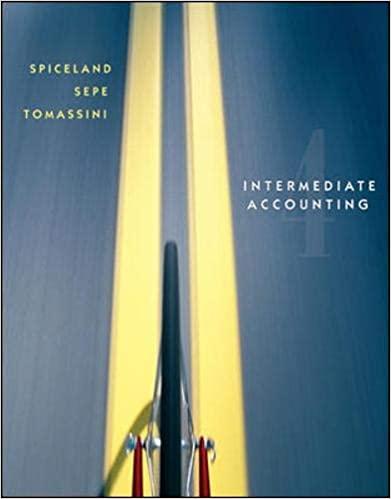Question
On Jan 1, 2016, PORE Inc. purchased 80% of the voting shares of SCORE Inc. for $900,000 cash, plus a commitment to pay an additional
On Jan 1, 2016, PORE Inc. purchased 80% of the voting shares of SCORE Inc. for $900,000 cash, plus a commitment to pay an additional $300,000 in three years if sales grow by more than 20% over the next three years. An independent business valuator stated that PORE Inc. could have paid an extra $100,000 at the date of acquisition instead of agreeing to a potential payment of $300,000 in three years.
On the date of acquisition, SCORE's Common Stock and Retained Earnings were valued at $200,000 and $600,000 respectively.PORE uses the cost method to account for its investment.
SCORE's fair values approximated its carrying values with the following exception:
The equipment had a fair value that was $ 100,000 higher than its carrying value, and was estimated to have a remaining useful life of 10 years from the date of acquisition with no salvage value.
SCORE's inventory had a fair value that was $2,000 more than book value. SCORE sold this inventory in 2016.
SCORE had an internally developed patent that had a fair value of $20,000 and can be used for four years. SCORE did not include the value of the patent on its financial records.
Both companies use straight line amortization exclusively for all assets and liabilities if applicable.
The effective tax rate for both companies is 40%.
In images there is income statement, retained earnings and balance sheet.
Other Information:
1. On Jan 2, 2016, SCORE purchased equipment for $70,000 and estimated its useful life would be 7 years with no salvage value. On Jan 1, 2019, SCORE sold the equipment to PORE for $80,000.Both companies use straight line depreciation.
2. During 2018, PORE sold a parcel of land to SCORE for $95,000. PORE had purchased this land in 2016 for $80,000. Score still has the land and uses as a warehouse space.
3. During 2019, PORE charged SCORE $15,000 of management fees. SCORE paid $10,000 during the year and expects to pay the remaining $5,000 in 2020.
4. During December 2019, PORE sold inventory to SCORE for $80,000, the cost of the inventory to PORE was $60,000. 40% of these goods remained in SCORE's inventory at the end of 2019.
5. During December 2018, SCORE sold inventory to PORE for $60,000, the cost of the inventory to SCORE was $30,000. 10% of these goods remained in PORE's inventory at the end of 2018. PORE eventually sold the entire inventory to an outside customer in 2019.
6. A goodwill impairment test conducted during December of 2017 revealed a loss of $50,000 and Dec of 2019 another loss of 35,000.
REQUIRED:
a) Prepare a schedule showing the calculation of goodwill at the date of acquisition of SCORE under the fair value enterprise method, and an acquisition differential amortization schedule.
b) Prepare a schedule showing the inter-company realized and unrealized profits. Your schedule should include both pre-tax and after-tax amounts.
c)Prepare the consolidated financial statements under the fair value enterprise method: Income statement and Retained Earnings for the year ended December 31st, 2019, and Balance Sheet as at December 31st, 2019. Show all supporting calculations.
NOTE: In preparing Consolidated Statement of Retained Earnings you need to calculate the opening retained earnings. Don't forget to show all your calculations.


Step by Step Solution
There are 3 Steps involved in it
Step: 1

Get Instant Access to Expert-Tailored Solutions
See step-by-step solutions with expert insights and AI powered tools for academic success
Step: 2

Step: 3

Ace Your Homework with AI
Get the answers you need in no time with our AI-driven, step-by-step assistance
Get Started


